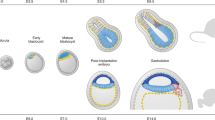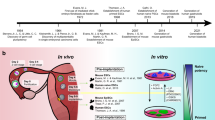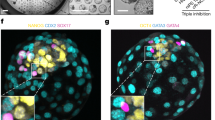Abstract
At the heart of the extensive ethical and regulatory debates that have surrounded human embryonic stem cells is the human pre-implantation embryo. Advances in the understanding of cellular reprogramming, both by cell nuclear replacement and by potential new protocols, should lead to methods that circumvent the use of a practicably viable embryo.
This is a preview of subscription content, access via your institution
Access options
Subscribe to this journal
Receive 12 print issues and online access
$189.00 per year
only $15.75 per issue
Buy this article
- Purchase on Springer Link
- Instant access to full article PDF
Prices may be subject to local taxes which are calculated during checkout

Similar content being viewed by others
References
Gey, G., Coffman, W. & Kubicek, M. Tissue culture studies of the proliferative capacity of cervical carcinoma and normal epithelium. Cancer Res. 12, 264–265 (1952).
Billingham, R. E. Contributions of transplantation to modern biology and medicine. Transplant Proc. 9, 34–48 (1977).
Starzl, T. E. & Zinkernagel, R. M. Transplantation tolerance from a historical perspective. Nature Reviews Immunol. 1, 233–239 (2001).
Thomson, J. A. et al. Embryonic stem cell lines derived from human blastocysts. Science 282, 1145–1147 (1998).
Reubinoff, B. E. et al. Embryonic stem cell lines from human blastocysts: somatic differentiation in vitro. Nature Biotechnol. 18, 399–404 (2000).
Polkinghorne, J. Review of the Guidance on the Research Use of Fetus and Fetal Material. (HMSO, London, 1989).
Shamblott, M. J. et al. Derivation of pluripotent stem cells from cultured human primordial germ cells. Proc. Natl Acad. Sci. USA 95, 13726–13731 (1998).
Trounson, A. & Pera, M. Potential benefits of cell cloning for human medicine. Reprod. Fertil. Dev. 10, 121–125 (1998).
Naito, H. et al. Xenogeneic embryonic stem cell-derived cardiomyocyte transplantation. Transplant Proc. 36, 2507–2508 (2004).
Hassink, R. J. et al. Human stem cells shape the future of cardiac regeneration research. Int. J. Cardiol. 95, (Suppl. 1) S20–S22 (2004).
Beltrami, A. P. et al. Adult cardiac stem cells are multipotent and support myocardial regeneration. Cell 114, 763–776 (2003).
Grounds, M. D. et al. The role of stem cells in skeletal and cardiac muscle repair. J. Histochem. Cytochem. 50, 589–610 (2002).
Hwang, W. S. et al. Evidence of a pluripotent human embryonic stem cell line derived from a cloned blastocyst. Science 303, 1669–1674 (2004).
Bradley, J. A., Bolton, E. A. & Pedersen, R. A. ES Cells for Transplantation: Coping with Immunity in Human Pluripotent Stem Cells (eds Odorico, J. S., Pedersen, R. A. & Zhang, S.-C.) (BIOS Scientific, Abingdon, UK, 2005).
Hochedlinger, K. & Jaenisch, R. Monoclonal mice generated by nuclear transfer from mature B and T donor cells. Nature 415, 1035–1038 (2002).
Holden, C. Stem cell research. Primate parthenotes yield stem cells. Science 295, 779–780 (2002).
Holden, C. & Vogel, G. Cell biology. A technical fix for an ethical bind? Science 306, 2174–2176 (2004).
Eistetter, H. R. Pluripotent embryonal stem cell lines can be established from disaggregated mouse morulae. Dev. Growth Differ. 31, 275–282 (1989).
Kanatsu-Shinohara, M. et al. Generation of pluripotent stem cells from neonatal mouse testis. Cell 119, 1001–1012 (2004).
Gurdon, J. B. The developmental capacity of nuclei taken from intestinal epithelium cells of feeding tadpoles. J. Embryol. Exp. Morphol. 10, 622–640 (1962).
Berardino, M. A. D. Genomic Potential of Differentiated Cells. (Columbia University Press, New York, 1997).
Wilmut, I. et al. Viable offspring derived from fetal and adult mammalian cells. Nature 385, 810–813 (1997).
Miller, R. A. & Ruddle, F. H. Pluripotent teratocarcinoma-thymus somatic cell hybrids. Cell 9, 45–55 (1976).
Do, J. T. and Scholer, H. R. Nuclei of embryonic stem cells reprogram somatic cells. Stem Cells 22, 941–949 (2004).
Byrne, J. A. et al. Nuclei of adult mammalian somatic cells are directly reprogrammed to oct-4 stem cell gene expression by amphibian oocytes. Curr. Biol. 13, 1206–1213 (2003).
Wagers, A. J. & Weissman, I. L. Plasticity of adult stem cells. Cell 116, 639–648 (2004).
Author information
Authors and Affiliations
Ethics declarations
Competing interests
The author declares no competing financial interests.
Rights and permissions
About this article
Cite this article
Evans, M. Ethical sourcing of human embryonic stem cells — rational solutions?. Nat Rev Mol Cell Biol 6, 663–667 (2005). https://doi.org/10.1038/nrm1698
Published:
Issue Date:
DOI: https://doi.org/10.1038/nrm1698
This article is cited by
-
Human Embryonic Stem Cells and Gene Therapy
Molecular Therapy (2007)



